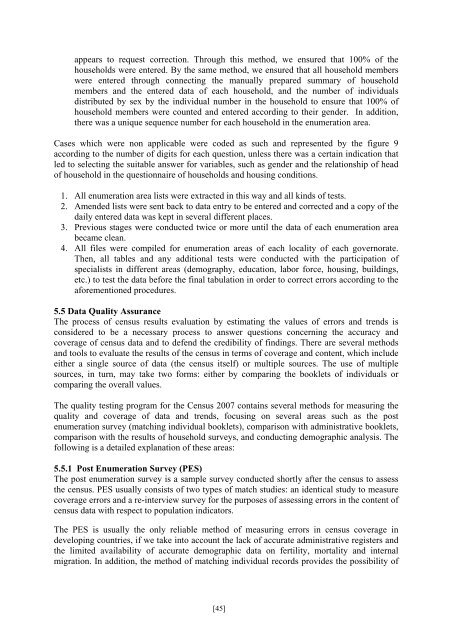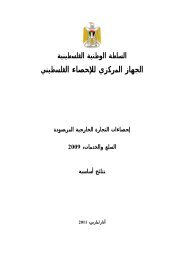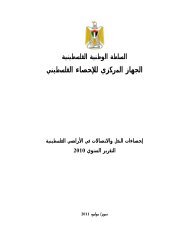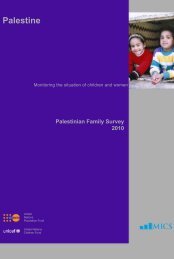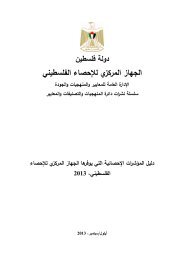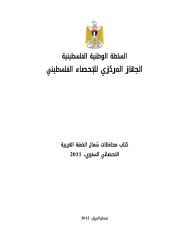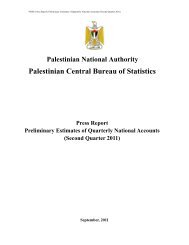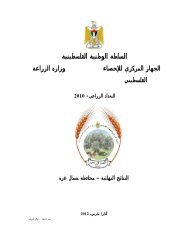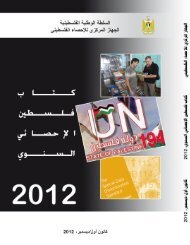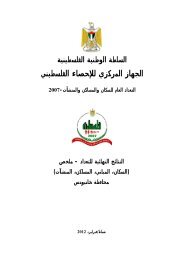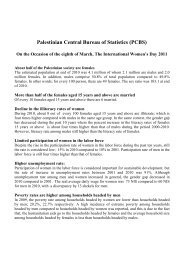اÙÙتائج اÙÙÙائÙØ© ÙÙتعداد ÙÙ Ùطاع غزة Ù Ùخص - Palestinian Central ...
اÙÙتائج اÙÙÙائÙØ© ÙÙتعداد ÙÙ Ùطاع غزة Ù Ùخص - Palestinian Central ...
اÙÙتائج اÙÙÙائÙØ© ÙÙتعداد ÙÙ Ùطاع غزة Ù Ùخص - Palestinian Central ...
You also want an ePaper? Increase the reach of your titles
YUMPU automatically turns print PDFs into web optimized ePapers that Google loves.
appears to request correction. Through this method, we ensured that 100% of the<br />
households were entered. By the same method, we ensured that all household members<br />
were entered through connecting the manually prepared summary of household<br />
members and the entered data of each household, and the number of individuals<br />
distributed by sex by the individual number in the household to ensure that 100% of<br />
household members were counted and entered according to their gender. In addition,<br />
there was a unique sequence number for each household in the enumeration area.<br />
Cases which were non applicable were coded as such and represented by the figure 9<br />
according to the number of digits for each question, unless there was a certain indication that<br />
led to selecting the suitable answer for variables, such as gender and the relationship of head<br />
of household in the questionnaire of households and housing conditions.<br />
1. All enumeration area lists were extracted in this way and all kinds of tests.<br />
2. Amended lists were sent back to data entry to be entered and corrected and a copy of the<br />
daily entered data was kept in several different places.<br />
3. Previous stages were conducted twice or more until the data of each enumeration area<br />
became clean.<br />
4. All files were compiled for enumeration areas of each locality of each governorate.<br />
Then, all tables and any additional tests were conducted with the participation of<br />
specialists in different areas (demography, education, labor force, housing, buildings,<br />
etc.) to test the data before the final tabulation in order to correct errors according to the<br />
aforementioned procedures.<br />
5.5 Data Quality Assurance<br />
The process of census results evaluation by estimating the values of errors and trends is<br />
considered to be a necessary process to answer questions concerning the accuracy and<br />
coverage of census data and to defend the credibility of findings. There are several methods<br />
and tools to evaluate the results of the census in terms of coverage and content, which include<br />
either a single source of data (the census itself) or multiple sources. The use of multiple<br />
sources, in turn, may take two forms: either by comparing the booklets of individuals or<br />
comparing the overall values.<br />
The quality testing program for the Census 2007 contains several methods for measuring the<br />
quality and coverage of data and trends, focusing on several areas such as the post<br />
enumeration survey (matching individual booklets), comparison with administrative booklets,<br />
comparison with the results of household surveys, and conducting demographic analysis. The<br />
following is a detailed explanation of these areas:<br />
5.5.1 Post Enumeration Survey (PES)<br />
The post enumeration survey is a sample survey conducted shortly after the census to assess<br />
the census. PES usually consists of two types of match studies: an identical study to measure<br />
coverage errors and a re-interview survey for the purposes of assessing errors in the content of<br />
census data with respect to population indicators.<br />
The PES is usually the only reliable method of measuring errors in census coverage in<br />
developing countries, if we take into account the lack of accurate administrative registers and<br />
the limited availability of accurate demographic data on fertility, mortality and internal<br />
migration. In addition, the method of matching individual records provides the possibility of<br />
[45]


